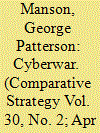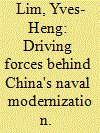| Srl | Item |
| 1 |
ID:
107946


|
|
|
|
|
| Publication |
2011.
|
| Summary/Abstract |
This article examines the interethnic politics in Pukhtunkhwa between the foreign "Wahhabis" (formerly known as the "Hindustani Fanatics" in India) and the local Pushtun tribesmen in the pre-9/11 era. It seeks to explain the inability of the early Wahhabis to coopt the Pushtuns with their Muslim "umma" narrative, as they sought to wage "jihad" against India and beyond from strongholds in Pukhtunkhwa. It highlights the persistence of the Wahhabis for almost two centuries in trying to "convert" the Pushtun to the sahih (correct) path of Islam (their version); the cultural roadblocks that ensured limited Wahhabi success in cleansing what they viewed as a jahiliyya society of mushriqun (deviant) Muslims who seemed to prefer their tribal identity over a religious one. It identifies the long-term repercussions of the Soviet's genocidal campaign (1979-1989) that led to the destruction of the traditional social fabric in Afghanistan's Pukhtunkhwa belt: the provision of an ideological opportunity for the Wahhabists to promote their Muwahiddun (unitarian) version of Islam through generous welfare and educational funding programs. It examines how the arrival of Arab "jihadis" in Peshawar, Pakistan in the 1980s marked the beginning of an indoctrination and co-option process that continues to this day, to the detriment of the Pushtuns' unique culture, language, and religious traditions/practices.
|
|
|
|
|
|
|
|
|
|
|
|
|
|
|
|
| 2 |
ID:
107944


|
|
|
|
|
| Publication |
2011.
|
| Summary/Abstract |
In recent years the People's Republic of China has garnered international attention for its aggressive and often sophisticated employment of cyber capabilities against domestic and international targets alike. With increasing frequency, the targets of Chinese cyber operations are American companies or government networks. If the United States and China find themselves in conflict in the coming decades, this newest arena of operations, cyberwarfare, will play a decisive role in determining the outcome. This article examines the relative cyber strengths and weaknesses each country commands today, and offers policy recommendations for the improvement of the United States' own cyberwar capabilities.
|
|
|
|
|
|
|
|
|
|
|
|
|
|
|
|
| 3 |
ID:
107945


|
|
|
|
|
| Publication |
2011.
|
| Summary/Abstract |
A nuclear deterrence policy will probably not be effective vis-à-vis a nuclear-armed Iran the way it was effective vis-à-vis the Soviet Union and China because of the present Iranian leadership. The West faces an unprecedented asymmetrical threat. While the West will be deterred by a nuclear-armed Iran, Iran may perceive its own nuclear weapons not as a deterrent but as the facilitator of a unique eschatological opportunity towards the God-promised worldwide rule of Imamite Shi'a Islam.
|
|
|
|
|
|
|
|
|
|
|
|
|
|
|
|
| 4 |
ID:
107943


|
|
|
|
|
| Publication |
2011.
|
| Summary/Abstract |
The rapid development of Chinese naval forces over the last decade has provoked much debate over where this modernization is headed. Observing the decennial evolution of Chinese naval forces, this article questions assumptions that China's naval modernization can be mainly explained by the enduring salience of the Taiwan question or by a "Mahanian" impulse. In the last ten years, China has prioritized the development of its submarine fleet and its sea-denial capacity, a choice that can be explained essentially by Beijing's position in the East Asian regional system and the disquieting presence of an adversarial global power.
|
|
|
|
|
|
|
|
|
|
|
|
|
|
|
|